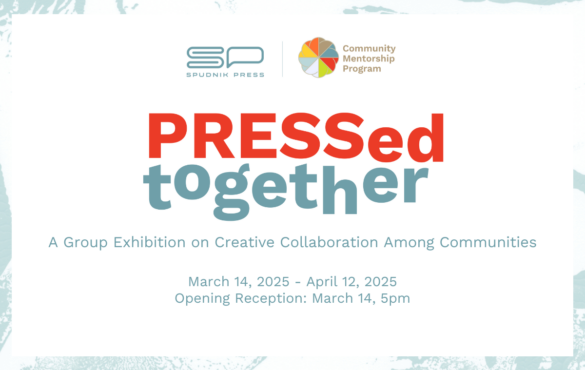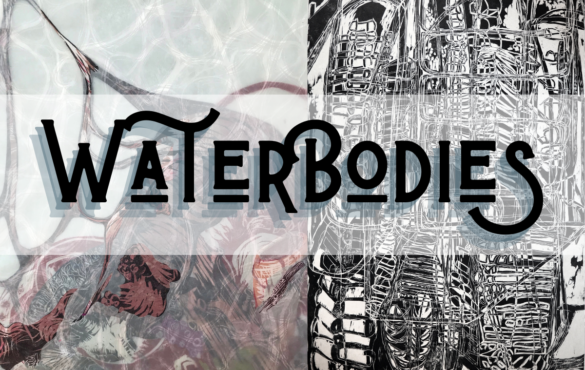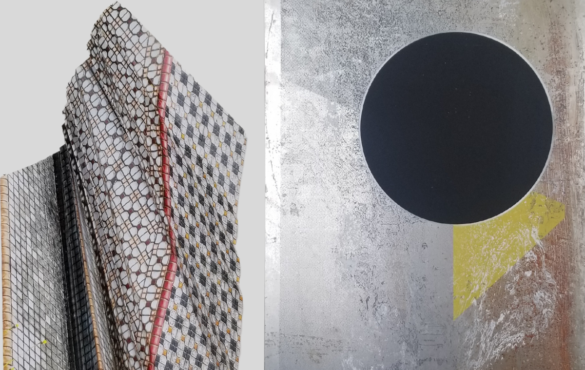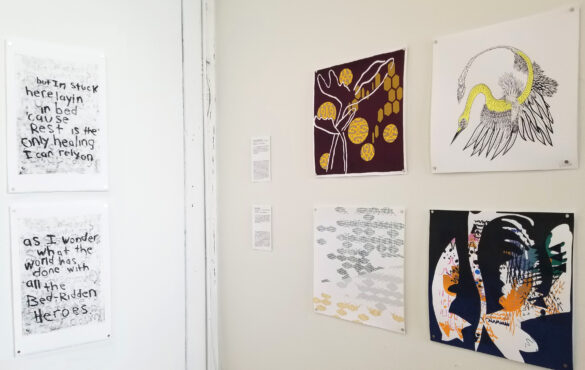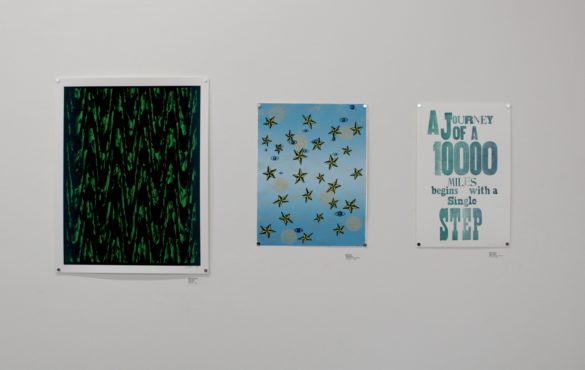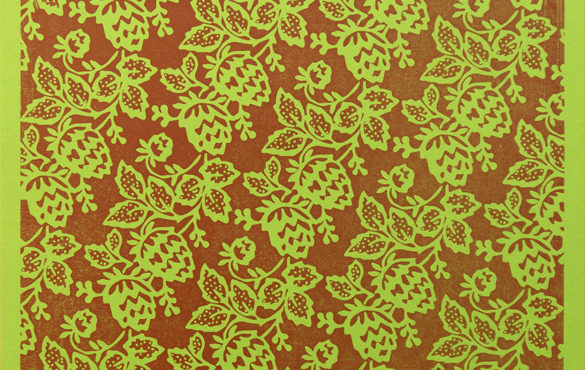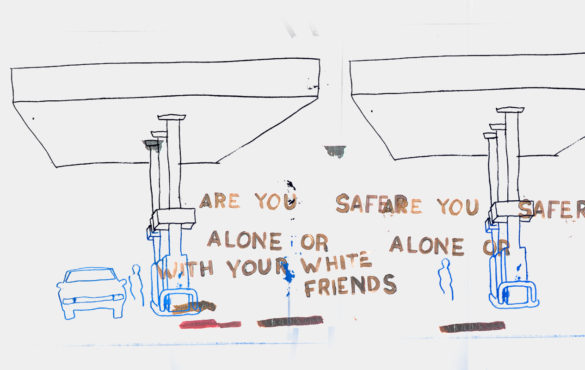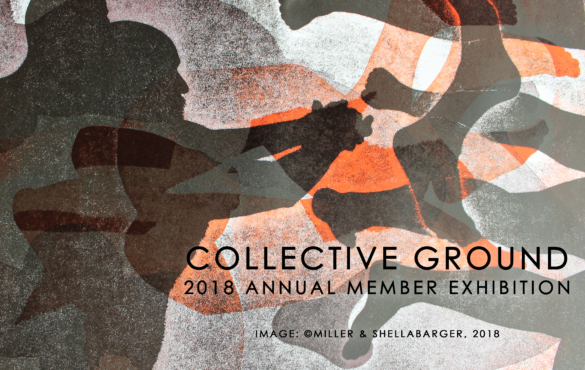Shop the Exhibition Here
Featured Artists:
Joshi Radin Flores | Steve Harhaj | Kelly Kristin Jones | Colleen Keihm | Alysha Kostelny | Nyeema Morgan | Siena Peterson | Alex Scott | Candace Turner
Dates:
March 14, 2025 – April 12, 2025
Location:
Spudnik Press Annex Gallery
Event:
PRESSed Together | Opening Reception
Friday, March 14
5:00pm CST
Visiting the Exhibition:
Visitors can make an appointment by emailing info@spudnikpress.org. Please include the date and time you would like to visit, and number of people in your party. We are typically able to accommodate visits between 10:00 a.m. – 6:00 p.m. Monday – Saturday and occasional weeknights.
About the Exhibition:
“PRESSed together” is the culminating group show of the artist cohort of Spudnik’s inaugural Community Mentorship Program. This exhibition is a collaboration of multiple communities with Spudnik Press, with 8 selected artists engaging in 6 weekly sessions on monotype printing under the guidance of Spudnik Press Teaching Artist and Mentor Anders Zanichkowsky. The curated prints from the program duration are available for purchase, benefiting participating artists, the organizations they represent, and Spudnik Press.
About the Cohort:
Joshi Radin Flores is an artist and writer living in Chicago. Working independently and collaboratively, she generates and examines practices of valuation and questions investigating nature, cosmology and expanded landscape. She completed MFA (2016) and MA (2018) degrees in Photography and Visual and Critical Studies as a New Artist Society merit scholar at the School of the Art Institute of Chicago. Her collaborative artist research group with Linda Tegg and Brian M. John, A Program for Plants, received a Shapiro Center EAGER grant for their investigations with plants and empathy. She has performed at Queens Museum, exhibited in the US and abroad, presented at conferences on art and ecology and published essays on art and nature. She had her first solo show of photographic works in the fall of 2017 and held the 2017 Dangler Curatorial Fellowship at The Art Institute of Chicago. She currently lectures in the photography department at the School of the Art Institute of Chicago.
Born in Chicago in 1949, Steve Harhaj joined the Chicago Studio in 2007. As an artist driven by process, repetition, and an interest in the natural world, Harhaj layers color and form to create idyllic landscapes populated by decoratively stylized imagery – chirping birds, perky tulips and daisies, ruffly clouds within clouds, and singular almond-shaped leaves that appear to float mid-air. Working across painting, drawing, and collage, his compositions are usually anchored by arches, multicolored grids, or radiating square patterns he describes as boxes, and given charmingly descriptive titles like Trees + Flowers + Leaves + Birds or Box Box Box Box Box Box Fence. He also often incorporates elements typical of classic Americana such as stars, American flags, county fairs, and picket fences. Using these recurring motifs, archetypal symbols, and patterns, he has devised an easily recognizable aesthetic reminiscent of folk art, and artists like William L. Hawkins and Morris Hirschfield.
Kelly Kristin Jones was raised on the West Side of Chicago and received her MFA from the School of the Art Institute of Chicago. She is the recipient of a number of awards and fellowships including a 2024 Illinois Arts Council Artist Fellowship Award and an Individual Artists Program Grant from the Chicago Department of Cultural Affairs and Special Events. She was a featured artist in the 2021 Chicago Architecture Biennial and the 2023 Chicago Humanities Festival.
Colleen Keihm (born in Levittown, NY and currently residing in Chicago, IL) received her BS from Drexel University and her MFA from the University of Illinois at Chicago. She is currently the Executive Director of Latitude which maintains a community digital lab and artist residency. Her work has been exhibited in Chicago at Flatland, Roman Susan, Filter Photo, and Tiger Strikes Asteroid. She has been an artist in residence at Hatch Projects at the Chicago Artist Coalition, Institut fur alles Mogliche in Berlin, Germany, and Writing Space in Chicago. Her work is a part of the photography collection at the Art Institute of Chicago, the Museum of Contemporary Photography, and she is a proud member of the Midwest Photographers Project.
Born and raised in Chicago, Alysha Kostelny currently lives on the Northwest Side. Kostelny’s approach to art-making is driven by experimentation, curiosity, and an exploration of various surfaces, textures, and applications of paint. She enjoys researching modern and contemporary artists, gleaning inspiration from myriad concepts and processes. Kostelny has a natural inclination toward hard-edge abstraction, though her work often straddles both abstraction and representation. Drawn to simplified organic forms and geometric shapes, she translates source imagery (often referencing art history, architecture, or the natural world) through reductive, bold color fields.
Nyeema Morgan’s work references familiar cultural material such as recipes, fables, canonical artworks and jokes to prompt reflection on the soft aesthetic power of systems of knowledge, information production and the mechanics of representation. Her conceptually layered works, ranging from large-scale drawings to sculptural installation and print based media, raise questions about how we articulate and construct meaning within a complex system of socio-political relations.
Siena Peterson is an interdisciplinary artist based in Chicago, IL. Her art practice is made up of various media including oil paint, charcoal, and performance work. Her work is an ongoing study of the personal battle of one’s internal and external self and is a way for her to document the bodily space that we inhibit and emotional depth hidden within. She received her BFA from The University of Illinois at Chicago in Interdisciplinary Education within the Arts and a minor in Fine Arts. Her work has been featured at The Hyde Park Art Center, Martin Gallery, Fulton Street Art Collective, and Figure One Gallery, among others. She was a selected resident of the LAUNCH Invitational Residency at the Chicago Artists Coalition in 2019, as well as the DAWA Artist Residency and Bridge Residency Cohort in 2022.
Alex Scott was born in 1987 and is a Chicago native. Known for his use of simplified forms and flat, bright colors, Scott’s fresh, direct approach to drawing and painting embodies a sense of nostalgia. His preferred materials are ballpoint pen, colored pencils, and acrylic. Scott’s influences range from cartoons and comics to classic mystery-comedy movies to children’s books, gaining continued inspiration from favorite books once read – The Phantom Tollbooth, Sam and the Firefly, In a People House by Dr. Suess, as well as books found in the studio. Neat arrangements of recurring characters, household objects, numbers, text, and symbols are frequently organized by letters of the alphabet and at times appear reminiscent of hieroglyphics. He often repetitively recreates past drawings or characters from memory with ease and accuracy, which results in slightly shifting iterations over years. This ongoing body of work exists across both individual works on paper and series of drawings in distinct sketchbooks. Recent exhibitions include EXPO Chicago, the Outsider Art Fair in NYC, Hand Drawn Circle at Intuit, and Dog Show curated by KG, among others. His work is part of the ArtBank permanent collection in McCook, Nebraska.
Born in 1990, Candace spent most of her 20s living at the notorious Shapiro Developmental Center, Illinois’s largest state institution. In 2019 she transitioned into a community setting, something she describes as having “saved” her. Candaces work embodies the sense of freedom she feels having been able to leave the institution. Groups of tattooed, scantily clad women imbue confidence as they lounge at the beach, dance together in their home, or pose nude in compositions that allude to historical masterpieces. Simple line work and flat fields of color create a consistent, distinct style that reflects Candace’s years of commitment to her practice. Candace’s brilliance is still blossoming as she embraces her freedom and develops a sense of self as a professional artist and a self actualized individual.
Program Mentor:
Anders Zanichkowsky came to Chicago in 2019 after getting their MFA from the University of Wisconsin-Madison where they concentrated in printmaking and religious art & studies. They are an interdisciplinary artist who also works in papermaking, textiles, neon, video, poetry, and performance, and they are the owner of Burial Blankets, weaving custom shrouds for green burial that are meant for enjoyment and reflection during life.
In 2016 Anders was an artist in residence with The Arctic Circle sailing expedition in Svalbard, and their work has been shown across the U.S. and abroad including The Wisconsin Film Festival and the Ukrainian Institute of Modern Art. Anders has taught all ages and backgrounds with a focus on printmaking, drawing, and DIY-style professional development for working artists, including while on staff at Spudnik from 2019 – 2021.
Program Curators:
Jill Nahrstedt is an artist, mother, surfer, and traveler exploring relationships between the self and place. She accomplishes this through the use of color and images in her paintings, pivoting between realism and abstraction, combining them both in some pieces. Jill is seeking the layers that make a life.
She is the founder and curator of Far North Side Gallery, a micro gallery in Chicago. Her work has been shown throughout the United States and can be found on several walls as Murals in Chicago where she lives with her husband and two children. Nahrstedt also prints serigraphs of local architectural groupings, dabbles in surf art, and paints portraits of stranger-neighbors she sources from social media.
Yang Pulongbarit-Cuevo is a papercut artist based in Chicago who began as a political cartoonist in the Philippines. Her work often draws inspiration from nature, anatomy, music, and folklore.
As an immigrant born and raised in an archipelago with rich cultural heritage contrasted by a history of political unrest, Pulongbarit-Cuevo also creates pieces informed by societal observations and emotional abstraction. Her work has been shown in exhibitions in California, New York, Illinois, and the Philippines, as well as publications including The Chicago Reader. She is currently serving as a board member for the Guild of American Papercutters and is working as managing director for Spudnik Press. On weekends, she hosts a weekly show for 107.1FM, an independent radio station in North Center Chicago.
Participating Organizations:
Arts of Life is a Chicago organization that advances the creative arts community by providing artists with intellectual and developmental disabilities a collective space to expand their practice and strengthen their leadership skills.
Latitude Chicago is a nonprofit community digital lab in Chicago that maintains high-end printing and scanning equipment, processes 35mm and 120 color negative film, operates an artist in residence program, and organizes ongoing arts programming.
——————–
Programs at Spudnik Press are partially supported by grants from the Illinois Arts Council Agency, the Driehaus Foundation, and the Gaylord & Dorothy Donnelley Foundation.
This project is partially supported by a Chicago Arts Recovery Program grant from the City of Chicago Department of Cultural Affairs & Special Events.
Logo designed by Riesling Dong
